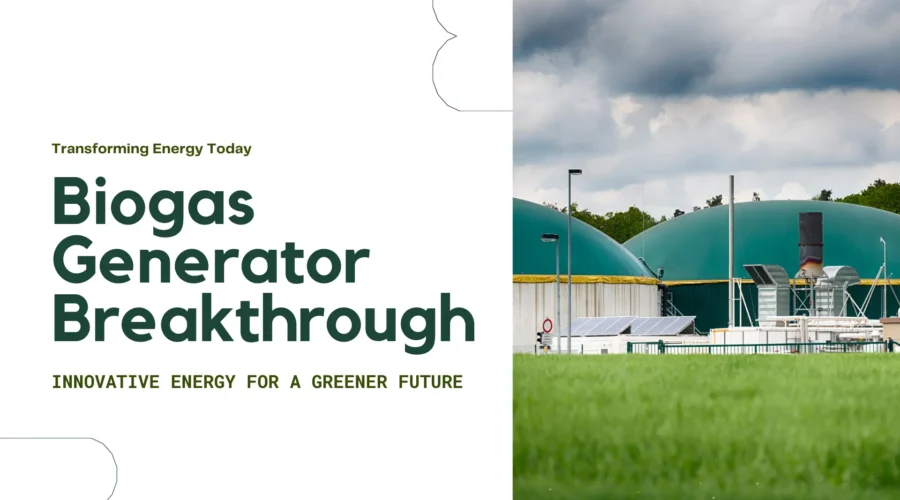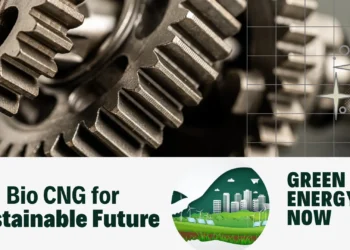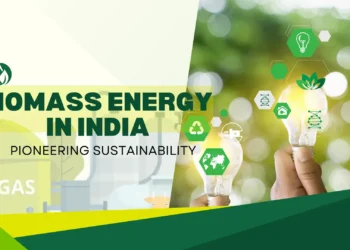Have you ever heard of Bio CNG? Bio CNG is a fuel made from natural…

Innovative Energy for a Greener Future: Biogas Generator Breakthrough
Biogas is a type of clean energy made from waste materials. It is created when leftover food, animal manure, and plant leaves break down. A biogas generator is the machine that helps turn this waste into valuable energy. Scientists and inventors have come up with new ways to make Biogas generators work even better. These ideas help us turn waste into useful energy, which protects the environment and supports a cleaner, greener future. Let’s learn how biogas generators are making a positive impact on the world!
What is a Biogas Generator?
It is like a magical machine that turns waste into valuable energy. It uses tiny organisms, called microbes, to break down organic waste in an environment without oxygen. As these microbes work, they produce biogas, a mixture of gases that includes methane. Methane is the central part of biogas and is used as fuel for cooking, heating, and producing electricity.
Why Are Biogas Generators Important?
Because it’s essential for many reasons:
- They help reduce waste using leftovers, animal manure, and other biodegradable materials.
- They produce clean energy that does not harm the environment.
- They minimise using fossil fuels like coal and oil, which pollute the air.
- They can save money for families and communities by providing a cheaper energy source.
Breakthroughs in Biogas Generators
Biogas generators have significantly improved because of new ideas and more innovative technologies. A biogas generator is a special machine that turns waste, like food scraps or animal manure, into energy. With these improvements, biogas generators now work faster and use fewer materials to create energy. This means they are not only saving resources but also helping the environment by reducing waste.
By using biogas generators, we can produce clean energy that can power homes, schools, and even farms. Biogas generators are incredible machines that help us turn waste, like food scraps and other organic trash, into something useful. They work by breaking down this waste to create biogas, which is a type of fuel that can be used for cooking, heating, or even making electricity. Biogas generators are becoming popular in many homes and neighbourhoods because of modern technology. These machines help us innovatively use waste by turning it into energy. Biogas generators are a clean and eco-friendly way to create energy while reducing the amount of trash we throw away. By using biogas generators, we can take a big step toward protecting our environment and using resources wisely. They have also become easier for people to use, making them an excellent choice for homes, farms, and communities. Let’s explore some of the most remarkable new developments in biogas generators and how they are helping us create clean energy.
1. Small-Scale Biogas Generators
Earlier, biogas generators were big and expensive, making them hard for small families to use. Now, scientists have created small-scale biogas generators that can fit in homes or small farms. These machines are easy to install and require less maintenance. For example, In India, one family uses a small biogas generator to turn their food waste into gas for cooking. This helps them save money and throw away less waste. The biogas generator makes it easy to recycle waste and use it in a helpful way.
2. High-Efficiency Designs
Modern biogas generators have improved designs that make them more efficient. “one of these generators” can produce biogas faster by creating the perfect environment for microbes to work. For example, the “plug flow digester” has a long, narrow tank where waste moves slowly, giving microbes enough time to break it down entirely. This method produces more biogas from the same amount of garbage.
3. Advanced Mixing Systems
Mixing the waste inside a biogas generator is a significant step. When the waste is not mixed properly, it can form layers that stop the tiny microbes from doing their job of breaking it down. To fix this problem, new and improved mixing systems have been created. These systems include tools like rotating paddles and gas bubbling methods, which help spread the waste evenly inside the biogas generator. By using these modern systems, biogas generators have become more dependable and work much better than before.
4. Smart Sensors and Monitoring
Modern technology has introduced smart sensors that can monitor the biogas generator. These sensors check the temperature, pH levels, and gas production. If something goes wrong, the sensors send alerts to the user. For example, a farmer in Germany uses a biogas generator with sensors. When the temperature drops too low, he gets a notification on his phone to adjust it. This ensures that the biogas production runs smoothly.
5. Use of Algae and Other New Materials
Usually, biogas generators use food waste and manure. But now, scientists have found that algae can also be a great source of biogas. Algae grow quickly and can be harvested from ponds and lakes. This method is beneficial in places with less agricultural waste. In a coastal town in Japan, researchers are using algae to produce biogas, providing energy for local homes.
6. Hybrid Biogas Generators
Hybrid biogas generators can work with both organic waste and solar energy. These machines use the heat from solar panels to speed up the digestion process. For example, in Kenya, a community project uses hybrid biogas generators to provide electricity for schools and homes. The combination of biogas and solar power makes the system very efficient.
7. Portable Biogas Generators
Portable biogas generators are small, lightweight, and easy to move. These generators are perfect for outdoor activities or remote areas. For example, campers in the United States use portable biogas generators to cook food while camping. These machines can turn food scraps into gas within hours.
8. Carbon Capture Technology
Biogas generators now come with carbon capture technology. This means they can trap carbon dioxide, which is a harmful gas, and keep it from entering the atmosphere. This technology makes biogas even cleaner. In Sweden, carbon capture technology is used in large biogas plants to produce energy while reducing greenhouse gases.
Step-by-Step Guide to Making Biogas with a Biogas Generator at Home
Step 1: Understanding Biogas Basics
- Biogas is a mixture of methane (CH4) and carbon dioxide (CO2) produced by anaerobic digestion of organic waste.
- Common feedstocks: kitchen waste, animal manure, crop residues, or food scraps.
Step 2: Required Machinery and Equipment
- Biogas Digester (Primary Component):
- Converts organic material into biogas.
- Types: Fixed-dome, floating-drum, or tubular digesters.
- Gas Storage Tank:
- For storing biogas produced.
- Gas Pipes and Valves:
- To transport gas from the digester to appliances.
- Slurry Outlet:
- To collect the nutrient-rich slurry (useful as fertiliser).
- Mixer or Grinder (Optional):
- To prepare feedstock for digestion.
- Safety Equipment:
- Pressure gauge, flame arrester, and gas leak detectors.
Step 3: Setup Process
- Select Location:
- Keep it simple: Put it close to the waste source and far from where people live to keep everyone safe.
- Install Digester:
- Follow the manufacturer’s guidelines. Ensure proper insulation for temperature control.
- Feedstock Preparation:
- Grind waste is used to increase the surface area and mixed with water (1:1 ratio) for optimal digestion.
- Initial Feed:
- Add starter material (cow dung or sludge) to introduce anaerobic bacteria.
- Connect Gas Storage:
- Secure gas pipes and install valves to control gas flow.
- Startup and Monitoring:
- Maintain digester temperature (30–40°C) for optimal bacterial activity.
Step 4: Equipment Costs
- Biogas Digester: $300–$2,000 (depending on size and type).
- Gas Storage Tank: $100–$500.
- Pipes and Valves: $50–$100.
- Optional Mixer/Grinder: $100–$300.
Total Initial Investment: $500–$3,000 (small-scale home system).
Step 5: Maintenance Schedule and Costs
- Daily: Feed the digester with organic waste.
- Weekly: Check gas leaks, pressure gauge, and slurry outlet.
- Monthly: Inspect pipes and valves and clean storage tank.
- Annual: Replace worn-out components and clean the digester tank.
Maintenance Costs: $50–$150 annually for a small setup.
Step 6: Potential Uses for Biogas
- Domestic Uses:
- Cooking, heating, and lighting.
- Agricultural Uses:
- Powering small machinery or water pumps.
Step 7: Selling Biogas and Byproducts
- Biogas:
- Compressed into CNG cylinders and sold to local businesses or households.
- Market price varies: $0.5–$1.0 per cubic meter.
- Slurry (Digestate):
- High-quality organic fertiliser, sold at $50–$100 per ton.
Step 8: Potential Profits
- Gas Revenue:
- A 2m³/day digester generates 60m³/month, earning $30–$60/month.
- Fertiliser Revenue:
- 1 ton/month digestate sold at $50 earns an additional $50/month.
Total Monthly Revenue: $80–$110. Payback Period: 2–3 years, depending on system size and local demand.
Where to Buy Equipment
- Local Suppliers: Search for nearby renewable energy equipment dealers.
- Online Platforms: Alibaba, Amazon, or specialised eco-energy websites.
- Specialised Companies: Companies like HomeBiogas or Biotech offer comprehensive solutions.
Real-Life Examples of Biogas Generator Success
- India: Many villages in India now use biogas generators to power their homes. Families collect cow dung and kitchen waste to produce biogas for cooking. This has reduced the need for firewood and improved air quality inside homes.
- China: In rural areas of China, biogas generators have transformed farming communities. Farmers use the generators to produce gas for cooking and heating, and the leftover material from the generator is used as fertiliser for crops.
- Europe: In countries like Germany and Sweden, large biogas plants generate electricity for cities. These plants use agricultural waste and food scraps from supermarkets to produce energy on a big scale.
- Africa: In Kenya and Rwanda, biogas generators are being used in schools to provide energy for students to cook meals. This has saved schools a lot of money and reduced their reliance on firewood.
Challenges and the Way Forward
While biogas generators have many benefits, there are still some challenges:
- Some people do not know how to use or maintain them.
- Initial costs can be high, even for small-scale models.
- There is a need for more awareness and training.
Many people face problems when trying to use this generator, but governments and organisations are helping to make things easier. They give money, called subsidies, to help people afford this. They also teach people how to use them through special training programs. They run awareness campaigns to make more people understand the benefits of biogas. For example, in Nepal, some local groups called NGOs work with farmers. They teach farmers how to use this generator properly so they can turn waste into useful energy for their homes and farms.
The Future of Biogas Generators
The future of biogas generators is inspiring and full of possibilities. Scientists are coming up with better materials and more innovative designs to make it work more efficiently and cost less money. Around the world, many governments are encouraging people to use biogas generators because they help reduce pollution and fight against climate change. As new ideas and improvements continue, it will become essential to building a cleaner, greener, and more sustainable world for everyone.
Conclusion
Biogas generators are special machines that change waste into valuable energy. These machines have improved a lot recently, making them work better, cost less, and easier for people to use. Biogas generators are helpful for everyone, no matter where they live—in tiny homes or large cities. These machines turn waste into energy, save money, and protect the environment. By using biogas generators, we can make the Earth cleaner and healthier. Let’s work together to use these fantastic tools and support clean energy for a brighter future.




Comments (0)